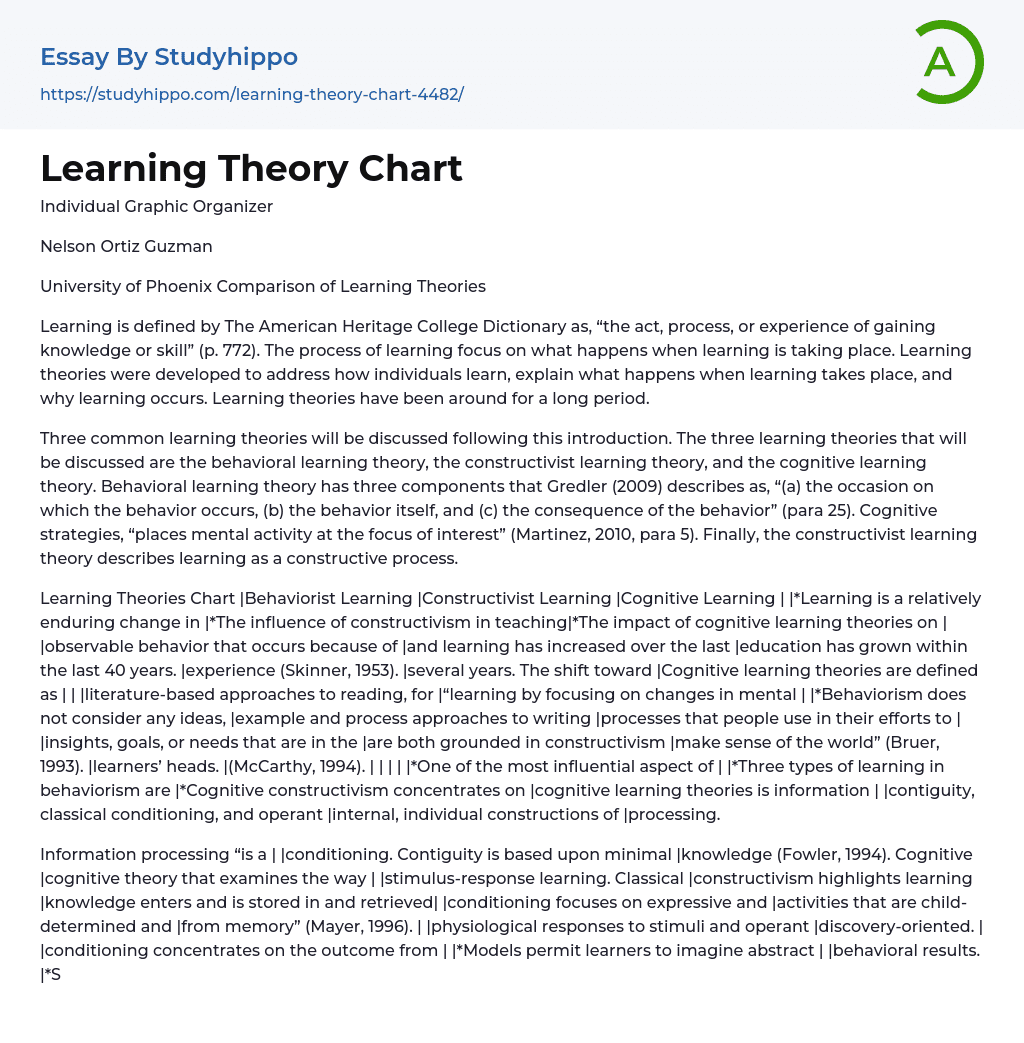Individual Graphic Organizer
Nelson Ortiz Guzman
University of Phoenix Comparison of Learning Theories
Learning is defined by The American Heritage College Dictionary as, “the act, process, or experience of gaining knowledge or skill” (p. 772). The process of learning focus on what happens when learning is taking place. Learning theories were developed to address how individuals learn, explain what happens when learning takes place, and why learning occurs. Learning theories have been around for a long period.
Three common learning theories will be discussed following this introduction. The three learning theories that will be discussed are the behavioral learning theory, the constructivist learning theory, and the cognitive learning theory. Behavioral learning theory has three components that Gredler (2009) describes as, “
a) the occasion on which the behavior occurs,
b) the behavior itself, and
c) the con
...sequence of the behavior” (para 25). Cognitive strategies, “places mental activity at the focus of interest” (Martinez, 2010, para 5). Finally, the constructivist learning theory describes learning as a constructive process.
Learning Theories Chart |Behaviorist Learning |Constructivist Learning |Cognitive Learning | |*Learning is a relatively enduring change in |*The influence of constructivism in teaching|*The impact of cognitive learning theories on | |observable behavior that occurs because of |and learning has increased over the last |education has grown within the last 40 years. |experience (Skinner, 1953). |several years. The shift toward |Cognitive learning theories are defined as | | |literature-based approaches to reading, for |“learning by focusing on changes in mental | |*Behaviorism does not consider any ideas, |example and process approaches to writing |processes that people use in their efforts to | |insights, goals, or needs that are in the |are both grounded i
constructivism |make sense of the world” (Bruer, 1993). |learners’ heads. |(McCarthy, 1994). | | | | |*One of the most influential aspect of | |*Three types of learning in behaviorism are |*Cognitive constructivism concentrates on |cognitive learning theories is information | |contiguity, classical conditioning, and operant |internal, individual constructions of |processing.
Information processing “is a | |conditioning. Contiguity is based upon minimal |knowledge (Fowler, 1994). Cognitive |cognitive theory that examines the way | |stimulus-response learning. Classical |constructivism highlights learning |knowledge enters and is stored in and retrieved| |conditioning focuses on expressive and |activities that are child-determined and |from memory” (Mayer, 1996). | |physiological responses to stimuli and operant |discovery-oriented. | |conditioning concentrates on the outcome from | |*Models permit learners to imagine abstract | |behavioral results. |*Social constructivists recognize the |relationships that are sometimes too difficult | | |involvement of others as it pertains to |to comprehend. | |*Consequences of behavior include reinforcement |learning. As individuals interrelate, the | | |and punishment.
Reinforcement is defined as a |development of distributing outcomes in |*As learners increase their metacognitive | |result that enhances the possibility that a |learners refining their own ideals and |abilities, they utilize approaches effectively | |behavior will reappear. Positive and negative |assisting to mold the idea of others plays |and efficiently. Metacognition function at the| |reinforcements are consequences that boost |an important role. |initial stage of the learning process. It can | |behavior.
On the other hand, punishment is an | |play a vital responsibility in perception and | |event that lessens the probability of a behavior | |“helps to regulate the flow of information | |happening again. | |through working memory” (Berk, 1997). | |
| | |
Learning Theories Graphic Organizer [pic] Note: Graphic organizer was created in MS PowerPoint and imported into this document as an image file. References (1997). The American heritage college dictionary. Boston, New York: Houghton Mifflin company. Berk, L. (1997). Child development. Boston: Allyn & Bacon. Bruer, J. (1993). Schools for thought: A science of learning for the classroom. Cambridge: MIT Press. Bruning, R (1995). Cognitive psychology and instruction. Upper Saddle River, NJ: Prentice Hall. Fowler, R. (1994).
Piagetian versus Vygotskian perspectives on development and education. Gredler, M. (2009). Learning and instruction. Theory into practice (6th edition). Upper Saddle River. NJ: Merrill Pearson Mayer, R. (1996). Learners as information processors. Educational Psychologist, 31(4), 151-161. Skinner, B. (1953). Science and human behavior. New York: Macmillan. McCarthy, S. (1994). The internalization of dialogue from social interaction during writing. Reading Research Quarterly, 29, 201-231. Martinez. M. (2010). Learning and cognition: The design of the mind Boston: Allyn and Bacon.
- Reinforcement essays
- Archetype essays
- Maturity essays
- Deception essays
- Certainty essays
- Conformity essays
- Aggression essays
- Behavior essays
- Human Behavior essays
- Obedience essays
- Adult essays
- Procrastination essays
- Morality essays
- Altruism essays
- Human Sexuality essays
- Role Model essays
- Perseverance essays
- Expressive essays
- Character Traits essays
- Apology essays
- Compassion essays
- Interpretation essays
- Plagiarism essays
- Analogy essays
- Learning English essays
- Abnormal Psychology essays
- Abraham Maslow essays
- Attachment Theory essays
- Authority essays
- Behaviorism essays
- Classical Conditioning essays
- Cognitive Psychology essays
- Counseling essays
- Developmental Psychology essays
- Educational Psychology essays
- Erik Erikson essays
- Family Therapy essays
- Jean Piaget essays
- Maslow's Hierarchy Of Needs essays
- Mental Health essays
- Operant Conditioning essays
- Personality Psychology essays
- Positive Psychology essays
- Psychoanalysis essays
- Psychotherapy essays
- Sigmund Freud essays
- Social Psychology essays
- Stanford Prison Experiment essays
- Supersize Me essays
- Coaching essays




